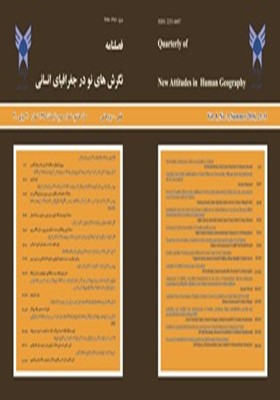تحلیل روابط فضایی شهرهای کوچک و روستاهای پیرامونی (مطالعه موردی: شهر گهواره در استان کرمانشاه)
محورهای موضوعی : کالبدی
1 - استادیار جغرافیا، دانشگاه آزاد اسلامی واحد کرمانشاه، کرمانشاه، ایران
کلید واژه:
چکیده مقاله :
چکیده افزایش جمعیت مناطق شهری تهران خارج از ظرفیت آن مشکلات کالبدی، اجتماعی، اقتصادی و زیست محیطی را برای برنامهریزان شهری و شهروندان فراهم آورده است که بخش بزرگی از این جمعیتپذیری ناشی از عدم توجه برنامهریزان به مسائل تراکمی میباشد. این معضل زمانی دوچندان میشود که در بافت فرسوده مناطق شهری برای ایجاد انگیزه در میان شهروندان جهت نوسازی بافت تسهیلاتی ارائه می گردد که ناخواسته تراکم جمعیتی را افزایش میدهد. هدف این پژوهش کاربردی، بررسی اثرات تراکم جمعیتی، تراکم کاربری و تراکم ساختمانی بر تابآوری، محلات ناحیه یک منطقه چهارده شهر تهران میباشد. در این پژوهش از مدل فازی استفاده شده است و روش جمعآوری دادهها نیز به صورت اسنادی و میدانی صورت گرفته است. نتایج حاصل رابطه منفی را بین تراکمهای شهری با تابآوری نشان میدهد یعنی با افزایش تراکم، میزان تابآوری محلات کاهش و آسیبپذیری آنها افزایش می یابد. از آنجایی که عدم قطعیت در مبحث تابآوری حایز اهمیت است مدل فازی بهترین گزینه برای نرمال نمودن دادهها میباشد که مورد استفاده قرارگرفته است. براساس این پژوهش محله دژکام بالاترین رتبه تراکمی را به خود اختصاص میدهد که نشان از پایین بودن تابآوری این محله و افزایش آسیبپذیری آن دارد و محله آهنگران با کمترین تراکم کاربری و تراکم ارتفاعی تابآورترین محله ناحیه یک منطقه 14 از منظر تراکمی میباشد.
References
Arianfar,A, (2002). The Role of building density in urban congestion control, case study: Zone 2 and 17 in Tehran, finishing a Master's Degree in Urban and Regional Planning Urban Planning, University of Science and Technology, Tehran.
Assistant of Urban Planning and Development Region14 of Tehran, (2012).
Azizi,M, (2002). Density in urban planning principles and criteria of urban density, Tehran University Press, first edition, Tehran.
Behtash,M, keynejad,M, pirbabaee,M, Asgari,A, (2014). Evaluate and analize the dimensions of resilience Tabriz, publication of Fine Arts- urbanity& architecture -N 18 Issue 3.
Burgess,R,(2000), The compact city debate: a global perspective compact cities, London: spon press.
Clarke, J (2006). Mahdavi,M, translate and edited: The principales and fundamentals of population geography, publisher: ghoomes publishing Co, Tehran,iran.
Ghaedrahmati, S. Bastanifar, I & Soltani, L, (2011). A Survey of Density Effect on the Vulnerability of Earthquake in Isfahan City (Fuzzy Approach), Geography and Environmental Planning Journal, 22th Year, vol. 41, No.1.
Habibi,M, masaeli,c,(1999). Per capita urban land use,ministry of housing and urban development national land &housing organization.
Hayraskar, J,K, (1989), Introduction to the Principles of Urban Planning Mohammad Soleimani and Ahmad unitary individual translations, publications University of Tarbiat Moallem University of Tehran.
Jome pour,M, Najafi,G, Shafia,S (2013). Extended abstract: Evaluation of relationship between density and social sustainability in Tehran Municipality’s regions, Geography and Environmental Planning Journal, 23rd Year, vol. 48, No.4.
Mayunga, Joseph S(2007), Understanding and applying the concept of community disaster resilience: a capital-base approach, A draft working paper prepared for the summer academy for social vulnerability are resilience building, Munich, Germany.
Philip Harrison, Kerry Bobbins, Christina Culwick,Tracy-Lynn Humby Costanza La Mantia, Alison Todes and Dylan Weakley( 2014), urban resilience thinking for municipalities, University of the Witwatersrand.
Pourmohamadi,M & ghorbani,R.(2003), Dimensions and Strategies compression paradigm spaces, Journal of humanities teacher, the seven th N29: 85-107.
Pourahmad,A, Habibi,K, Zahray,S, Nazari,S(2007). The use of fuzzy algorithms and GIS to locate urban site selection (Case Study Babolsar landfill), Journal of Ecology 33 (42), Tehran University.
Quaranteli, E, L.(2003). Urban vulnerability to disaster in developing countries: managing risk. in building safer cities. Washington.
Ramezanzadeh,l,M,(2014). Thesis social and economic structure of rural residents' resilience against natural disasters with emphasis on floods, Tehran University
Rezaei,M, (2014), Assessment of economic and institutional resilience of urban communities against natural disasters Case Study: Earthquake neighborhoods of Tehran, Journal of Disaster Management, No. 3.
Shahr o khaneh Consulting Engineers (2006). The summary of a detailed plan area 14.
Shirani,H, (2003). Organizing Position, knowledge creation publications, Tehran.
Tehran Geographic Information Center (Municipality of Tehran), (2005). Atlas of Tehran metropolis, Processing and planning in Tehran Co.
Vojoudi,M, Zare,M, (2006). Fuzzy inference model to analyze the earthquake, natural disaster management conference, Tehra.
Waugh,w,l, (2000). Living with hazard: dealing with disaster, an introduction to emergency management, New York, USA, M.E. Sharpe, Inc.
Ziari, k, (2002). Urban land use planning, Yazd University, Yazd printing.

